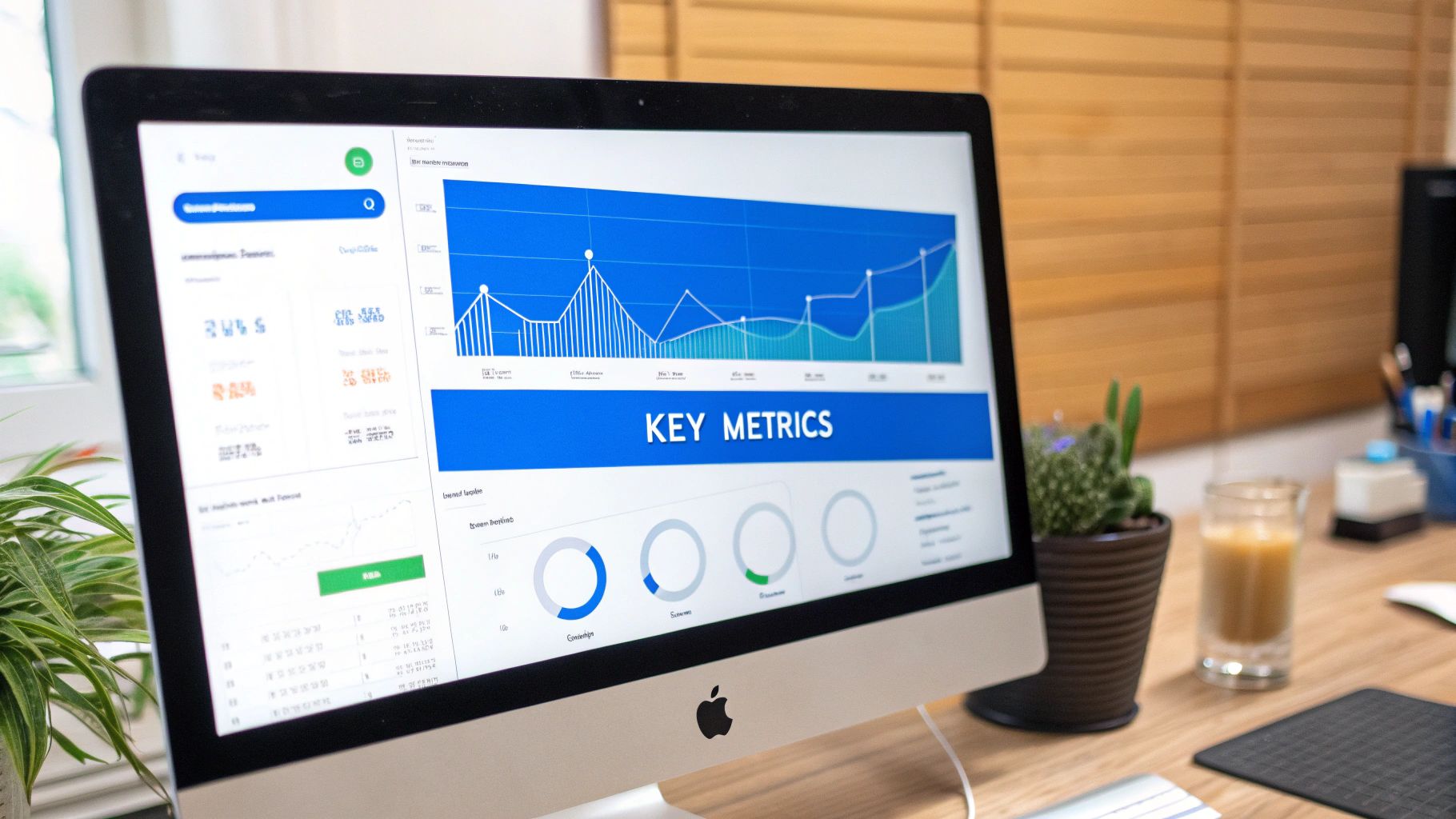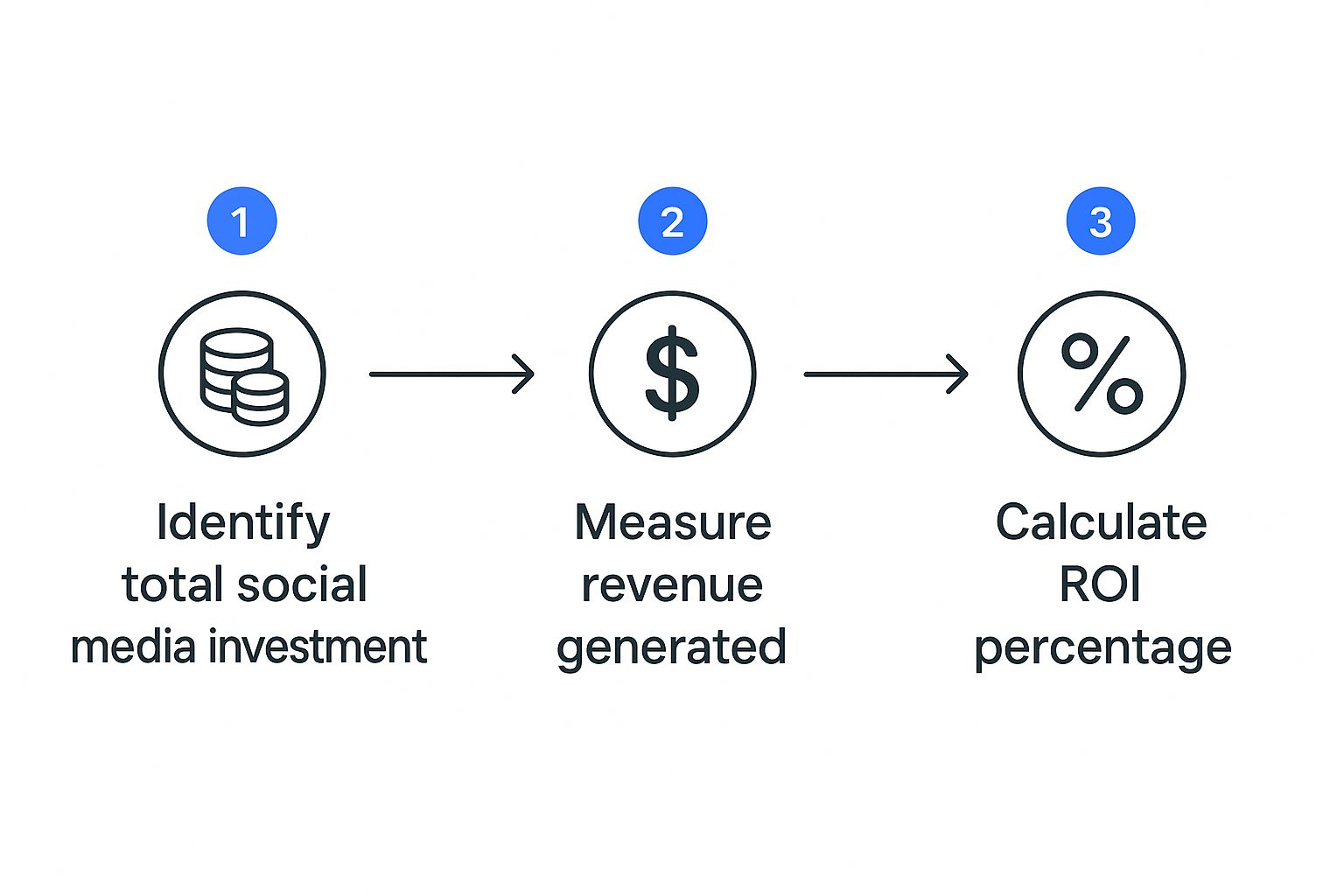Let's be honest: translating likes, shares, and comments into actual financial results can feel like a guessing game. A social media ROI calculator is the tool that stops the guesswork. It moves you past the vanity metrics and helps you prove exactly how your social media efforts are impacting the bottom line, giving you the hard data you need to defend and optimize your marketing spend.
Why a Social Media ROI Calculator Is Essential for Your Strategy

We've all been there—trying to justify a social media budget to stakeholders who only care about hard numbers. Without clear proof of return, your hard work can easily be dismissed as a "cost center" instead of the growth engine it truly is. This is precisely why a social media ROI calculator isn't just a nice-to-have; it's a must-have for any serious marketer.
It’s the bridge between what happens on your social feeds and what happens on your balance sheet. Instead of just reporting follower growth, you can start demonstrating how your campaigns are generating qualified leads, driving sales, and building long-term customer loyalty. That shift is what gets you bigger budgets and a real seat at the strategy table.
Pinpoint Your High-Performing Campaigns
One of the biggest wins is finally being able to see what’s really working. When you calculate the ROI for specific platforms and individual campaigns, you can stop guessing and start making decisions backed by actual data.
You might find that your fun, unpolished TikTok videos are driving a much higher ROI than your carefully crafted LinkedIn articles, even if the LinkedIn content got more compliments from the C-suite. That’s a powerful insight. It tells you exactly where to double down and where to pull back resources from channels that simply aren't delivering.
This data-first approach is quickly becoming the norm. As businesses demand more clarity, reliance on these tools has skyrocketed. A recent survey showed that over 70% of companies are now using an ROI calculator or a similar analytics tool to gauge their effectiveness. Even better, this shift has helped marketers slash excess marketing spend by 15-20% year-over-year just by identifying those underperforming channels. You can discover more insights on social media ROI tools from Vaizle.com.
Translate Fuzzy Value into Cold, Hard Cash
We know social media builds brand equity, but how do you put a price tag on that? A calculator is what helps you assign a monetary value to actions that aren't a direct sale.
By tracking metrics like lead value or customer lifetime value (CLV), a social media ROI calculator helps you demonstrate long-term impact. A lead generated from a Facebook ad today might turn into a loyal customer who makes multiple purchases over several years.
This framework gives you the confidence to defend your strategy and prove the real, tangible value of your work. It helps you speak the language of your CFO, turning abstract concepts like "brand awareness" into concrete financial returns. That’s how you solidify social media's role as a critical driver of the business.
Gathering the Metrics That Actually Matter

Any social media ROI calculator is only as good as the data you plug into it. It’s a classic case of "garbage in, garbage out." If you want a figure that means something—one you can actually use to make decisions—you have to dig deeper than surface-level stats.
This really boils down to two core components: everything you spent (your investment) and everything you earned back (your return). Nailing this part of the process is non-negotiable for getting an accurate picture of your performance.
Tallying Up Your True Social Media Investment
First, let's talk about what you're actually spending. It’s so much more than just your ad budget. I've seen countless marketers make the mistake of only counting their ad spend, which gives them a wildly inflated—and misleading—ROI.
To get it right, you need to account for every single dollar, both direct and indirect.
Here’s what you should be tracking as an investment:
- Ad Spend: This one’s the no-brainer. It's the total cash you put directly into paid ads on Facebook, Instagram, TikTok, or wherever you’re running campaigns.
- Content Creation Costs: Think about what it took to make your posts. Did you pay a photographer for a product shoot? Hire a videographer for a reel? Those invoices are part of your investment.
- Social Media Tools: Don't forget the subscriptions. Your scheduling platform, analytics software, and even design tools like Canva or the Adobe Creative Suite all have a cost.
- Team Hours: This is the cost that gets missed most often. You have to account for your team's time. Calculate the hourly rate for everyone involved in your social media efforts and multiply it by the hours they dedicated to the campaign. It adds up quickly.
Calculating social media return on investment is complex because expenditures and returns extend beyond direct ad spend. Beyond the actual campaign cost, other investments include freelance copywriting, graphic design, and internal team hours. A complete social media ROI calculator needs these detailed inputs to provide an accurate profitability figure. You can read more about these comprehensive calculations on Mentionlytics.com.
Pinpointing Your Actual Financial Return
Once your costs are tallied, it’s time to look at the other side of the equation: the return. This is where you connect your social media activity to real business outcomes. Likes and shares are nice for gauging audience sentiment, but they don't pay the bills and won't help you calculate a meaningful financial ROI.
You need to track actions that have a clear dollar value attached. For an e-commerce business, this is pretty straightforward—sales directly from a social campaign. For B2B, it might be the value you assign to a new, qualified lead. If you want to go deeper on this, our guide on the most important social media metrics is a great place to start.
Before you can calculate ROI, you need a clear breakdown of your investments and returns. The table below outlines the essential data points you need to collect.
Essential Metrics for Your ROI Calculation
| Metric Category | Specific Data Points to Track | Why It's Important |
|---|---|---|
| Investments (Costs) | Ad Spend, Agency/Freelancer Fees, Software Subscriptions, Team Salaries (pro-rated hours), Content Production Costs | This gives you the "I" in ROI. Without a complete picture of your total investment, your final ROI figure will be inaccurate and overly optimistic. |
| Returns (Gains) | Direct Revenue (from UTM tracking), Value of Leads Generated, Customer Lifetime Value (CLV) from social, Branded Search Lift | This gives you the "R." Tracking tangible financial gains is the only way to prove that social media is contributing to the bottom line, not just creating buzz. |
Gathering this data upfront is the most critical part of the process. With these numbers in hand, you’re ready to see what your efforts are really worth.
Here are the return metrics that truly matter:
- Direct Revenue: This is the gold standard. By using UTM parameters in your links, you can trace sales directly back to a specific post or ad. It’s the cleanest metric for measuring return.
- Lead Value: Not every conversion is a sale, especially in B2B. You need to assign a monetary value to each lead. A simple way to do this is by looking at your historical data: what percentage of leads become customers, and what is the average sale price?
- Customer Lifetime Value (CLV): For a more sophisticated analysis, look at the long-term value. A customer who found you on social media might only spend $50 on their first purchase, but if they come back three more times a year, their CLV is significantly higher. This shows the true, long-term impact of your social channels.
By meticulously tracking both your complete investment and your true financial return, you’re giving your ROI calculator the high-quality fuel it needs to produce a number you can actually trust and build a strategy around.
Making the Social Media ROI Formula Work for You
Alright, you've done the hard work of tracking down your investment costs and defining what "return" means for your brand. Now it's time for the fun part: putting it all together to see what the numbers really say. The math itself isn't complicated, but applying it to a real campaign is what transforms abstract data into a story of success (or a lesson learned).
The classic formula is beautifully simple: (Return - Investment) / Investment x 100%. The result is a straightforward percentage that tells you exactly how profitable your social media efforts have been.
Let's ground this in a real-world scenario.
A Real-World Example: An Ecommerce Campaign
Imagine you own an online store and you've just dropped a new collection of sustainable activewear. You decide to go all-in on Instagram for a one-month promotional push.
Here’s what you spent:
- Instagram Ad Spend: You put $800 behind some carefully targeted ads.
- Influencer Marketing: You partnered with two micro-influencers, costing a total of $500.
- Content Creation: A freelance photographer shot the new collection for $200.
That brings your total investment to $1,500. After the month is up, you dive into your analytics. Thanks to solid UTM tracking, you can confidently say the campaign drove $4,500 in direct sales.
Now, let's plug those numbers into our formula:
(4,500 - 1,500) / 1,500 x 100 = 200%
A 200% ROI is fantastic. It's a clear, powerful number you can take to your team or stakeholders. It means for every single dollar you put into this campaign, you got two dollars back in profit. That’s a win.
This visual breaks down the process into three simple stages.

As you can see, it’s a repeatable flow: tally your investments, measure your returns, and then calculate the final percentage. This works for any campaign you run. For an even deeper dive into your marketing spend, you might want to use a customer acquisition cost calculator to see how this fits into your larger strategy.
What About Return on Ad Spend (ROAS)?
While you're calculating ROI, you’ll almost certainly hear people talk about ROAS, or Return on Ad Spend. It's a different, more specific metric. Think of it as a zoom-in on just your advertising performance.
ROAS = Revenue from Ads / Ad Spend
Let’s go back to our activewear example. Your ROAS would be $4,500 / $800 = 5.6x. This tells you that for every $1 you spent specifically on Instagram ads, you brought in $5.60 in revenue.
ROAS is perfect for quickly judging if your ads are hitting the mark. ROI, on the other hand, gives you the full story on the profitability of the entire campaign, including all the other costs. You really need both to get a complete picture of your financial performance.
Turning Your ROI Results Into Actionable Insights
You’ve crunched the numbers and have your social media ROI. Now what? That number isn't the finish line; it’s the starting pistol. Think of it less like a final grade and more like a diagnostic report from a doctor. It tells you exactly where to look, what to question, and how to fine-tune your strategy for better results.
A positive ROI is a clear signal to double down on what’s working. But a negative ROI? That’s not a failure. It’s an invaluable piece of feedback telling you it's time to investigate and optimize. The real goal here is to transform that raw data into a concrete plan that makes every single dollar you spend work smarter and harder for your business.
https://www.youtube.com/embed/rkcOPqLRu38
What to Do When Your ROI Is Low
If the numbers are looking a little grim, don't sweat it. This is a super common scenario and, more importantly, it's fixable. Your job now is to put on your detective hat and pinpoint which part of your social media funnel is leaking money. In my experience, the culprit is almost always hiding in one of these three places.
H3: Are You Talking to the Right People?
Your ads could be award-winning, but if you're showing them to an audience that couldn't care less about your product, you're just throwing money away. This is a classic targeting issue.
Dig deep into your audience analytics. Are the demographics, interests, and behaviors you're targeting truly aligned with your ideal customer? Sometimes the audience we think we should target isn't the one that actually converts.
H3: Is Your Content or Offer Missing the Mark?
Okay, so your targeting is spot on. The next question is: is your message compelling? An uninspired visual, confusing copy, or a weak call to action can stop a great campaign dead in its tracks. This is a creative or offer problem.
And don't forget the offer itself. Is it genuinely valuable enough to make someone stop scrolling and take action? If the incentive isn't strong enough, even the best creative won't save it.
H3: Is Your Landing Page Leaking Conversions?
You've nailed the ad, and people are clicking. Fantastic! But what happens next? A clunky, slow-loading, or confusing landing page is the ultimate conversion killer. I’ve seen this sink so many otherwise brilliant campaigns.
This is all about post-click friction. The journey from the social post to the final conversion needs to be absolutely seamless. If there's any point of frustration, potential customers will bounce.
A rookie mistake is blaming the social media platform when the real problem is the landing page experience. Your ROI calculation covers the entire customer journey, so you have to scrutinize every step to find that weak link.
How to Systematically Improve Your Results
Once you have a hunch about what's wrong, it’s time to start testing.
Your new best friend is A/B testing. The key is to test one single variable at a time. Change the ad headline. Swap the main image. Tweak the button color on your landing page. You'd be amazed how small, methodical changes can lead to massive jumps in your ROI.
Another pro tip is to find your winners and reallocate your budget accordingly. If you notice that Instagram is driving a ton of sales while your Facebook efforts are flatlining, it might be time to shift your focus. Our guide on social media cross-posting shows how you can do this efficiently, maintaining a presence everywhere while putting your money where it counts the most.
Making the Case for a Bigger Budget
When you have a strong, positive ROI, you hold the ultimate trump card for getting more resources. The key is how you frame the conversation with your boss or leadership team. Stop talking about costs and start talking about investment and growth.
- Don't say: "We spent $2,000 on social media last month."
- Do say: "Our $2,000 investment in social media generated $8,000 in revenue, delivering a 300% ROI."
See the difference? You've reframed social media from a line-item expense into a profit-generating machine.
This is where a dedicated social media ROI calculator becomes incredibly valuable. These tools are built to quantify financial impact and often include visual reporting features that make your presentations sharp, clear, and data-driven. You can discover more insights about these ROI tools on BusinessInitiative.org.
By turning your ROI data into a compelling story of success, you don't just justify your current budget—you prove that social media is a critical engine for the entire business.
Common Mistakes When Calculating Social Media ROI

Even with the right formula, it's surprisingly easy to get your social media ROI wrong. A few common slip-ups can completely skew your numbers, leading you to make bad decisions based on faulty data. Honestly, a botched calculation is worse than none at all—it can give you a false sense of security or make a winning strategy look like a total failure.
One of the biggest traps I see people fall into is focusing only on direct, last-click revenue. This completely ignores the messy, roundabout way people actually make buying decisions. Social media often plants the seed, introducing someone to your brand long before they ever dream of clicking "buy."
Forgetting the 'Soft' Costs
When you add up your investments, it's simple to remember the obvious stuff like ad spend and software subscriptions. But so many marketers forget to include the "soft costs," which are just as real and can seriously throw off your numbers. The big one? Your team's time.
The salary for your social media manager, a portion of the graphic designer's hours, the time your copywriter sinks into crafting posts—these are all real, tangible investments. If you forget to factor them in, your ROI will look artificially high, and you'll get a misleadingly rosy picture of your performance.
A true picture of your social media investment requires a full accounting of all resources.
- Employee Time: Figure out the hourly rate for each team member involved and multiply it by the hours they spent on a specific campaign or time period.
- Content Production: This includes any fees for photographers, videographers, or stock assets you purchased.
- Training and Development: Did your team take a course to level up their skills? That's a direct investment in your social media program and belongs in the calculation.
The Problem with Last-Touch Attribution
Another major pitfall is relying on flawed attribution models. This is what happens when you give 100% of the credit for a sale to the very last thing a customer clicked before buying. It’s a classic mistake.
Here’s a real-world scenario: a potential customer sees your Instagram ad on Monday. On Wednesday, they read one of your blog posts. Then, on Friday, they finally type your brand into Google, click a search ad, and make a purchase. With a last-touch model, Google Ads gets all the glory, and your social media efforts look like they generated zero value. This model is just too simplistic and misses the critical brand-building work social media does.
You simply can't measure the true value of your social strategy if you only credit the final click. The customer's journey is a conversation between multiple channels, and social media often starts that conversation.
A much better approach is to recognize that each touchpoint played a role. That's why modern analytics tools are shifting toward multi-touch attribution models, which distribute credit more fairly across the entire customer path. For a deeper dive into handling these complex workflows, check out our guide to essential social media management tips, which can help you track these efforts more effectively.
Ignoring Non-Monetary Returns
Finally, you have to remember that not every campaign is about driving immediate sales. Far from it. Many campaigns are built for brand awareness, fostering community engagement, or improving customer sentiment. If you ignore these non-monetary returns, you’re missing a massive piece of the value puzzle.
While it’s definitely harder to slap a dollar value on a positive comment or a brand mention, it’s not impossible. You can estimate the value of your earned media, for instance, by calculating what similar reach would have cost you in paid ads.
Overlooking these intangible benefits means you'll undervalue your most successful awareness campaigns and likely make poor strategic choices down the line. A truly accurate ROI calculation finds a way to account for all types of value, not just the ones that are easiest to measure.
Common Questions We Hear About Social Media ROI
Even when you have the formula down pat, calculating social media ROI can still feel a bit tricky. Some questions come up time and time again. Let’s walk through a few of the most common ones so you can feel confident in every number you report.
How Do I Calculate ROI for Brand Awareness Campaigns?
This is a big one. When your campaign isn't directly aimed at making a sale, the trick is to assign a real monetary value to metrics that feel "soft." It's all about connecting things like likes and shares to tangible business results.
First, you'll want to track your key performance indicators—think reach, impressions, and engagement rate. The real work comes next: linking those numbers to your actual business goals. For example, dive into your past data. Have you noticed that a 20% bump in social media engagement consistently leads to a 5% lift in website traffic from those channels? Great. Now you can assign a value to that traffic based on your website's average conversion rate.
A smart way to think about this is to calculate your earned media value. Figure out what it would have cost you in paid ads to get the same reach and impressions. This method puts a hard number on the "fuzzy" benefits of brand awareness and makes it much easier to justify your budget for those top-of-funnel efforts.
What Is a Good Social Media ROI to Aim For?
I wish I could give you a single magic number, but the truth is, a "good" ROI is all over the map. It really depends on your industry, profit margins, and what you’re trying to accomplish with a specific campaign. Still, there are some general benchmarks that can help you get your bearings.
Many marketers I know shoot for a 5:1 ratio, which works out to a 400% ROI. Basically, for every dollar you put in, you get five dollars back. When looking specifically at Return on Ad Spend (ROAS), a 4:1 ratio is generally seen as a solid performance.
But context is everything.
- Low-margin businesses, like retail, often need a much higher ROI to see a real profit.
- New businesses trying to carve out market share might be perfectly happy with a lower or even break-even ROI for a while.
Ultimately, what matters most is establishing your own baseline. Your real goal should be to keep getting better, always aiming to beat your own last record.
Should I Use a Free Calculator or a Paid Analytics Tool?
This decision really comes down to the size of your business and how complex your marketing is. Both have their place.
Free online calculators are fantastic for quick, back-of-the-napkin math. If you're a small business, a solopreneur, or just running a simple, one-off campaign, they’re perfect for getting a handle on the basics. The downside? You have to plug in all the numbers yourself.
On the other hand, paid analytics platforms like Sprout Social or Hootsuite are a game-changer for larger businesses or agencies juggling multiple clients. Their biggest selling point is automation.
| Feature | Free Calculator | Paid Analytics Tool |
|---|---|---|
| Data Entry | Manual | Automated (via API integrations) |
| Reporting | Basic, manual creation | Real-time, customizable dashboards |
| Attribution | Simple, last-touch focused | Advanced multi-touch models |
| Best For | Small businesses, learning | Larger teams, complex campaigns |
These tools sync directly with your social accounts, pulling data automatically into real-time dashboards. You get much deeper insights, a look at what your competitors are doing, and sophisticated models for figuring out which touchpoints led to a sale. It saves a staggering amount of time and gives you a much clearer, more accurate picture of what’s actually working.
Ready to stop guessing and start growing? PostOnce simplifies your entire social media workflow with powerful automation and cross-posting features. Create your content once, and let our platform handle the rest, ensuring every post is perfectly optimized for every network.
Start saving time and amplifying your reach with PostOnce today.